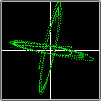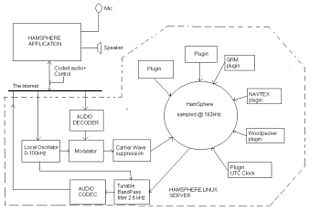
MT63 is a digital radio modulation mode for transmission in high-noise situations developed by Pawel Jalocha SP9VRC. MT63 is designed for keyboard-to-keyboard conversation modes, on HF amateur radio bands.

MT63 is a digital radio modulation mode for transmission in high-noise situations developed by Pawel Jalocha SP9VRC. MT63 is designed for keyboard-to-keyboard conversation modes, on HF amateur radio bands.
MT63 distributes the encoding of each character over a long time period, and over several tones. This code and symbol spreading implementation is key to its robustness under less than ideal conditions. The MT63 mode is very tolerant of mistuning, as most software will handle 120 Hz tuning offsets under normal conditions.
| Mode | Symbol rate | Typing speed | Duty cycle | Modulation | Bandwidth | ITU designation |
|---|---|---|---|---|---|---|
| MT63-500 | 5 baud | 5.0 cps (50 wpm) | 80% | 64 × 2-PSK | 500 Hz | 500HJ2DEN |
| MT63-1000 | 10 baud | 10.0 cps (100 wpm) | 80% | 64 × 2-PSK | 1000 Hz | 1K00J2DEN |
| MT63-2000 | 20 baud | 20.0 cps (200 wpm) | 80% | 64 × 2-PSK | 2000 Hz | 2K00J2DEN |
One shortcoming of MT63 is that robustness is somewhat compromised with the short interleaver.
Latency (delay between transmitted characters) is more than 6 seconds with the long interleaver.
The typical character transmission delay is 12.8 seconds with long interleave mode.
| Mode | ECC mode | Latency (sec) |
|---|---|---|
| MT63 500 Hz | short | 12.8 |
| MT63 1K | short | 6.4 |
| MT63 1K | long | 12.8 |
| MT63 2K | short | 3.2 |
| MT63 2K | long | 6.4 |
| PSK31 | - | <1 |
MT63 is seeing a resurgence in its popularity on shortwave with the VOA Radiogram [1] but the software used to encode the text is not using the Varicode that MT63 used in its original design.
Modern software that codes MT63, such as Fldigi, has opted for base128 [2] that is essentially ASCII-7. However, the only interleaving options have become long and short, as the medium interleaving mode has become redundant.
MT63 has been promoted as a modulation format for Time Signal Stations, but the implied system does not use Varicode. [3]

Radioteletype (RTTY) is a telecommunications system consisting originally of two or more electromechanical teleprinters in different locations connected by radio rather than a wired link. Radioteletype evolved from earlier landline teleprinter operations that began in the mid-1800s. The US Navy Department successfully tested printing telegraphy between an airplane and ground radio station in 1922. Later that year, the Radio Corporation of America successfully tested printing telegraphy via their Chatham, Massachusetts, radio station to the R.M.S. Majestic. Commercial RTTY systems were in active service between San Francisco and Honolulu as early as April 1932 and between San Francisco and New York City by 1934. The US military used radioteletype in the 1930s and expanded this usage during World War II. From the 1980s, teleprinters were replaced by personal computers (PCs) running software to emulate teleprinters.

Slow-scan television (SSTV) is a picture transmission method, used mainly by amateur radio operators, to transmit and receive static pictures via radio in monochrome or color.

Shortwave radio is radio transmission using shortwave (SW) radio frequencies. There is no official definition of the band, but the range always includes all of the high frequency band (HF), which extends from 3 to 30 MHz ; above the medium frequency band (MF), to the bottom of the VHF band.

Digital Radio Mondiale is a set of digital audio broadcasting technologies designed to work over the bands currently used for analogue radio broadcasting including AM broadcasting—particularly shortwave—and FM broadcasting. DRM is more spectrally efficient than AM and FM, allowing more stations, at higher quality, into a given amount of bandwidth, using xHE-AAC audio coding format. Various other MPEG-4 and Opus codecs are also compatible, but the standard now specifies xHE-AAC.

PSK31 or "Phase Shift Keying, 31 Baud", also BPSK31 and QPSK31, is a popular computer-sound card-generated radioteletype mode, used primarily by amateur radio operators to conduct real-time keyboard-to-keyboard chat, most often using frequencies in the high frequency amateur radio bands (near-shortwave). PSK31 is distinguished from other digital modes in that it is specifically tuned to have a data rate close to typing speed, and has an extremely narrow bandwidth, allowing many conversations in the same bandwidth as a single voice channel. This narrow bandwidth makes better use of the RF energy in a very narrow space thus allowing relatively low-power equipment to communicate globally using the same skywave propagation used by shortwave radio stations.
AX.25 is a data link layer protocol originally derived from layer 2 of the X.25 protocol suite and designed for use by amateur radio operators. It is used extensively on amateur packet radio networks.
The Hellschreiber, Feldhellschreiber or Typenbildfeldfernschreiber is a facsimile-based teleprinter invented by Rudolf Hell. Compared to contemporary teleprinters that were based on typewriter systems and were mechanically complex and expensive, the Hellschreiber was much simpler and more robust, with far fewer moving parts. It has the added advantage of being capable of providing intelligible communication even over very poor quality radio or cable links, where voice or other teledata would be unintelligible.
The Bell 103 modem or Bell 103 dataset was the second commercial modem for computers, released by AT&T Corporation in 1962. It allowed digital data to be transmitted over regular unconditioned telephone lines at a speed of 300 bits per second. It followed the introduction of the 110 baud Bell 101 dataset in 1958.
Olivia MFSK is an amateur radioteletype protocol, using multiple frequency-shift keying (MFSK) and designed to work in difficult conditions on shortwave bands. The signal can be accurately received even if the surrounding noise is 10 dB stronger. It is commonly used by amateur radio operators to reliably transmit ASCII characters over noisy channels using the high frequency (3–30 MHz) spectrum. The effective data rate of the Olivia MFSK protocol is 150 characters/minute.
Multiple frequency-shift keying (MFSK) is a variation of frequency-shift keying (FSK) that uses more than two frequencies. MFSK is a form of M-ary orthogonal modulation, where each symbol consists of one element from an alphabet of orthogonal waveforms. M, the size of the alphabet, is usually a power of two so that each symbol represents log2M bits.

PSK63 is a digital radio modulation mode used primarily in the amateur radio field to conduct real-time keyboard-to-keyboard informal text chat between amateur radio operators.
PACTOR is a radio modulation mode used by amateur radio operators, marine radio stations, military or government users such as the US Department of Homeland Security, and radio stations in isolated areas to send and receive digital information via radio.
Q15X25 is a communications protocol for sending data over a radio link. It was designed by amateur radio operator Pawel Jalocha, SP9VRC, to be an open communications standard. Like all amateur radio communications modes, this protocol uses open transmissions which can be received and decoded by anyone with similar equipment. Q15X25 is a form of packet radio. It can be used to interconnect local VHF AX.25 packet networks over transcontinental distances. Anyone can design or adapt the open-source software to develop their own Q15X25 system.
In computing, telecommunication, information theory, and coding theory, an error correction code, sometimes error correcting code, (ECC) is used for controlling errors in data over unreliable or noisy communication channels. The central idea is the sender encodes the message with redundant information in the form of an ECC. The redundancy allows the receiver to detect a limited number of errors that may occur anywhere in the message, and often to correct these errors without retransmission. The American mathematician Richard Hamming pioneered this field in the 1940s and invented the first error-correcting code in 1950: the Hamming (7,4) code.
A radiogram is a formal written message transmitted by radio. Also known as a radio telegram or radio telegraphic message, radiograms use a standardized message format, form and radiotelephone and/or radiotelegraph transmission procedures. These procedures typically provide a means of transmitting the content of the messages without including the names of the various headers and message sections, so as to minimize the time needed to transmit messages over limited and/or congested radio channels. Various formats have been used historically by maritime radio services, military organizations, and Amateur Radio organizations.
WSJT-X is a computer program used for weak-signal radio communication between amateur radio operators. The program was initially written by Joe Taylor, K1JT, but is now open source and is developed by a small team. The digital signal processing techniques in WSJT-X make it substantially easier for amateur radio operators to employ esoteric propagation modes, such as high-speed meteor scatter and moonbounce.

HamSphere is a subscription-based internet service which simulates amateur radio communication using VoIP connections over the Internet. The simulator allows licensed radio amateurs and unlicensed enthusiasts to communicate with one another using a simulated ionosphere. It was designed by Kelly Lindman, a radio amateur with call sign 5B4AIT.

Fldigi is a free and open-source program which allows an ordinary computer's sound card to be used as a simple two-way data modem. The software is mostly used by amateur radio operators who connect the microphone and headphone connections of an amateur radio SSB or FM transceiver to the computer's headphone and microphone connections, respectively.
Fast Simple QSO(FSQ) is an amateur radio digital differential frequency modulation mode developed by Con Wassilieff ZL2AFP with Murray Greenman ZL1BPU in 2015.